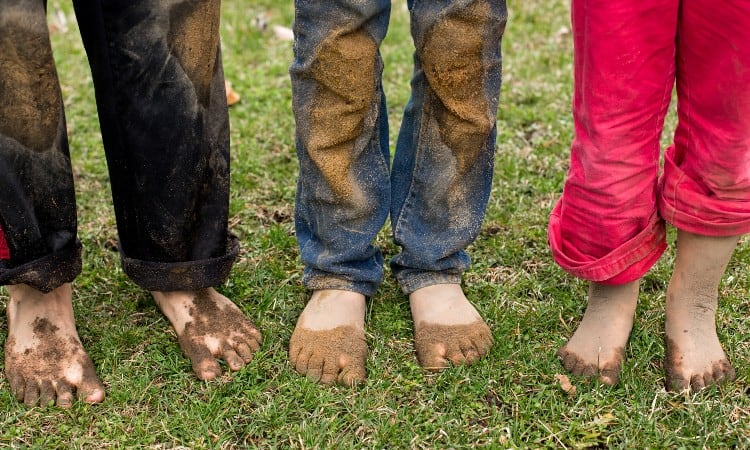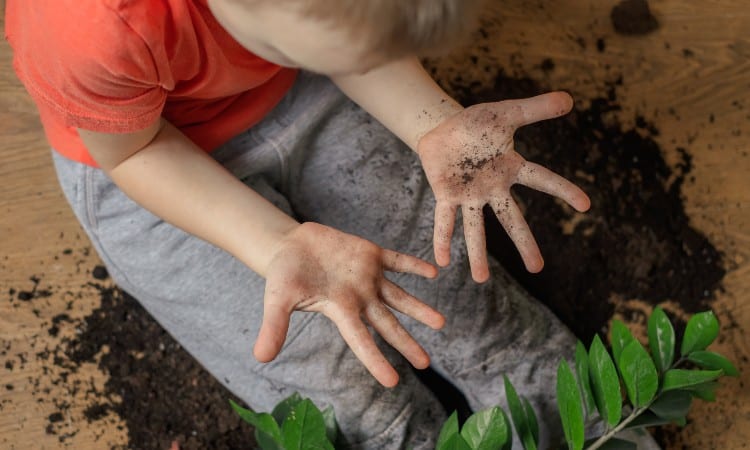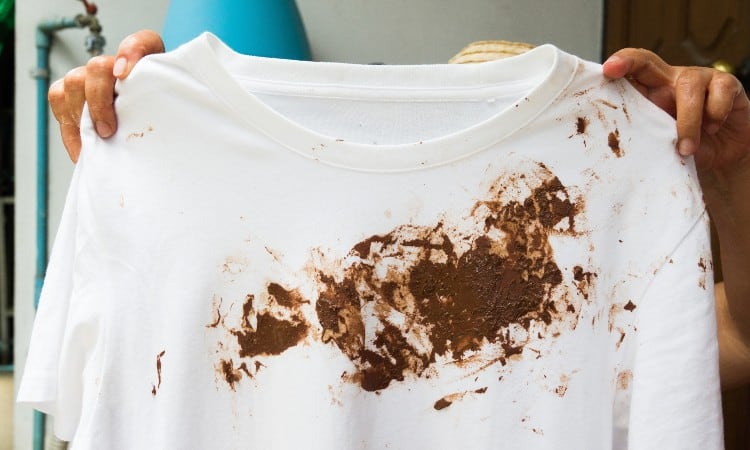If you play sports like soccer, getting mud and dirt on your clothes is a part of life. Getting them off again can be a challenge. Is there an easy way to clean them? How can you get dirt stains out of clothes?
To remove dirt stains from clothes:
- Allow the dirt to dry.
- Once dry, scrape the surface dirt off the fabric.
- Treat the area with liquid detergent and gently rub it into the stain with a toothbrush.
- Leave it to soak for 15 minutes.
- Wash on a heavy soil setting in a washing machine.
- Allow the garment to air dry.
In this article, you’ll learn what causes dirt stains. You’ll also discover the easiest and best way to banish them from your clothes.

Quick Navigation
- Does Mud Stain Clothes?
- Are Dirt Stains Permanent?
- How to Get Dirt Stains Out of Clothes
- How to Remove Dirt Stains After Clothes Have Been in the Dryer
- How to Get Dirt Stains Out of White Clothes
- Can I Wash Mud Out of Dry Clean Only Clothes?
- How to Get Wet Sand Stains Out of Clothes
- How to Get Mud off Leather
- Conclusion
Does Mud Stain Clothes?
Yes, mud can stain clothes. Mud is essentially wet soil. Made up of dirt, dust, and plant debris, the ground around us is a hodge-podge of different particles mixed together. Sometimes it can contain traces of excrement from animals and birds. So not only does mud stain clothes, but it can also make them smell.
Dirt isn’t an easy substance to avoid. Whenever you go outside, you come into contact with it. Whether you are an avid soccer player, hiker, parent, gardener, or dog owner, dirt on your clothes will be a part of your life.
When it’s dry, dirt is a lightweight material that can get blown around by the wind. It doesn’t only cover your clothes; and it can cover sidewalks and cars. Rubbing against something covered in the dirt will transfer it to your clothing.
A simple shake of your coat or brushing down your pants with your hands will return the dusty substance to the ground where it belongs as long as your hands are dry.
Add a bit of moisture and dirt becomes a soggy gloop. Better known as mud, this liquid form of dirt is harder to remove. Wet hands can push the dust particles into the fabric of your clothes. Washing the clothing adds even more water and the particles seep further into the material.
Slide across a mud-soaked soccer pitch or get splashed by a muddy dog, and you have an even bigger problem. Mud loves to cling to fabric. The bigger the area, the wetter the mud, and the more it will cause stains on your clothes.
Are Dirt Stains Permanent?
No, dirt stains don’t have to be permanent. However, it can feel like they are when you’re trying to clean your clothes.
Part of the reason dirt stains become permanent is the action you take when you become aware of them. The biggest mistake you can make when dealing with dirt stains is trying to remove them while they are still wet. Another is putting dusty clothing straight into the washing machine without brushing it off first.
Putting the clothing into the dryer will further compound the issue. You see, heat from the dryer will act like a setting agent, ensuring that pesky mud stain becomes permanent.
Even after washing wet mud and drying your clothes in the dryer, removing mud stains from clothes is still possible. It will be more difficult and may require a couple of treatments. But, there is a way to remove those unsightly mud stains you believed to be permanent. I’ll show you how later in this article.
How to Get Dirt Stains Out of Clothes

Removing dirt stains from your clothes is a lot easier than you think. All you need to do is forget everything you know about stain removal. Your instinct will scream at you to remove the mud while it’s still wet. Ignore that urge.
You need a different approach to dirt and mud. Dirt stains are not the same as wine stains and shouldn’t be treated similarly. I’ve put together a step-by-step guide to show you how to remove dirt and mud simply and effectively. Follow these instructions and your mud stain woes will disappear.
You will need:
- Clothes brush
- Vacuum cleaner
- Lint roller
- Butter knife
- Toothbrush
- Washing machine
- Your usual laundry detergent
- Stain remover
- Borax
- Distilled white vinegar
- Baking soda
Dealing With Dry Dirt
Step 1
Brush the surface dirt off with a clothes brush. You can also use a vacuum cleaner, but make sure you use the vacuum cleaner’s wand and the upholstery brush. Give it a bit of a shake, too, as this will loosen any remaining dust particles.
Step 2
Run a lint roller over the garment as this will pick up any loose dirt particles still present on the surface of the clothing.
Step 3
Check your garment label. If it is a dry clean only item, take it to a dry cleaner for professional cleaning. If it’s washable, prewash the garment with a commercial stain remover.
Then wash the item as you would normally. Adding ¼ cup of borax will boost your laundry detergent and help it get rid of any remaining dirt dust to help prevent stains. Putting ¼ cup of vinegar in the final rinse will make sure all traces of detergent and borax are removed.
Once the wash cycle has been completed, check for signs of residual dirt before drying the garment. If it has all been removed, you can dry the clothing. To be safe, air dry on a clothesline. Only use your dryer if you are positive all the dirt has gone.
Dealing With Mud
Step 1
Before you do anything else, check the care label on your garment. You need to make sure it is washable. If the label says “dry clean only”, don’t try to wash the mud stains out. Take it to a professional dry cleaning facility. The hints and tips I’ll show you in this section will only work on washable clothing.
Step 2
You’ll need to take a deep breath for this one. Once you’ve identified your garment as washable, the next thing you want to do is nothing. That’s right. Step away from the clothing and let that mud dry.
Step 3
Once it is completely dry, scrape off the surface mud with your butter knife. The edge of an old credit card will work too. Next, brush the garment with a clothes brush to remove any remaining flakes of dried mud.
Step 4
Soak the stained area with liquid detergent. Leave the garment for 15 minutes to let the detergent seep into the fibers. Grab your toothbrush and hold it under cold running water until it is wet. Then, use the toothbrush to work the detergent into the stain. Use a circular motion working from the inside of the stain outwards. Leave the garment for 10 minutes and rub it again with the toothbrush.
Step 5
Apply stain remover to the area. You can use a commercial stain remover for this. Rub it into the stain with your toothbrush. Then, leave it to soak into the stain for 5 minutes.
Step 6
Wash the garment as you would normally using your usual laundry detergent. Add ¼ cup of borax to give your detergent an extra boost. Put ¼ cup of distilled white vinegar in the final rinse to remove all traces of borax and detergent. Once the cycle has been completed, check the item for signs of staining. If there are none, move on to step 7.
You might find there is a residual smell caused by the mud. You can spray this with distilled white vinegar. Or sprinkle baking soda on the area. Leave the garment overnight. Check again in the morning. Should any stains or smells still exist, repeat step 6. If not, go on to step 7.
Step 7
It’s time to dry your garment. The best way to do this is to hang it on an external clothesline and allow it to dry naturally. Sunlight will help kill off any remaining bacteria from the dirt and help eliminate any residual odors. Including any smell from the vinegar if you used it in the last step.
Avoid using your dryer until you are 100% convinced that all the mud has been removed. The heat from the dryer will set the mud stain, making it permanent. Or at least a lot harder to expel.
How to Remove Dirt Stains After Clothes Have Been in the Dryer
It’s all too easy to miss dirt stains on clothes. Especially if they are in a hard-to-see area, you might not see the stain until you take the garment out of the dryer.
Sometimes dryers can be a hindrance in the laundry room. They may dry your clothes in half the time it takes them to dry naturally. But, any stains leftover from the wash will be set into your garment permanently.
Or at least, that’s how it will seem. Once stains have been exposed to the heat of a dryer, they will be harder to remove. You’ll need help from a commercial cleaning product. One such product is GoJo.
Gojo is a hand cleaner that removes oil, dirt, and grease. It contains pumice but has no harsh solvents making it safe to use on your skin. This makes it a good mud remover for fabric too.
There is a slight word of caution, though. Gojo contains pumice which is abrasive. Always do a spot check to make sure the product won’t damage the fabric of your clothing. Don’t use GoJo or any abrasive product on silk or other delicate items.
You will need:
- Gojo or similar hand cleaning product
- Toothbrush
- Your usual laundry detergent
- Washing machine
Step 1
Spread the hand cleaner onto both sides of the stained area. Using your toothbrush, rub it into the stain. Use circular movements and work from the inside of the stain to the outside. Leave the garment to soak up the hand cleaner for at least an hour. Longer would be better for large or stubborn stains.
Step 2
Wash the garment as you would normally. Put the machine on a setting designed for heavily soiled items. When the wash cycle has been completed, re-set the machine to repeat the cycle. Don’t add any more detergent, though.
Step 3
Check the garment for any remaining stains. If there are some, repeat the above steps. Only dry your garment when you are happy the stains have been removed. Air drying is the safest method. Don’t use your dryer.
How to Get Dirt Stains Out of White Clothes

Getting dirt stains out of white clothes is similar to getting them out of colored clothing. However, you do have to be careful what products you use. Always use a detergent designed for white clothing and don’t be tempted to add any chlorine bleach to the wash.
Although bleaching white clothing has been considered to be the way to remove stains, it’s not a good idea. Bleach can strip the brightness from your whites. Depending on the fiber content of your clothes, it can also turn them yellow.
You will need:
- Detergent suitable for white clothing
- Washing machine
- Stain remover
- Borax
- Distilled white vinegar
Step 1
Check your garment’s care label. You need to make sure the item is washable before following these steps. If it’s dry clean only, take it to a dry cleaner to be professionally cleaned.
Step 2
Pre-treat the mud stain with a stain remover. Then wash it in your machine on a heavy soil setting. Make sure the detergent you use is suitable for white clothing. Avoid using any product containing bleach, as this can cause your whites to turn yellow. If you want to add an extra boost to your laundry detergent, put ¼ cup of borax in the wash.
Step 3
Add ¼ cup of vinegar to the final rinse. This will ensure all the detergent and borax have been removed. When the cycle has ended, check the garment for stains. You might have to repeat these steps if any traces of mud are left behind.
Step 4
Once you are happy all the stains have gone, air dry your garment. The sun’s power will act as a brightener to make your white garment look whiter. It will also bleach out any residual marks from the stain. Don’t be tempted to use your dryer. If you’ve missed any stains, the dryer’s heat will set them into the fabric.
Can I Wash Mud Out of Dry Clean Only Clothes?
No, you can’t wash dry clean only clothes. Not even if they are covered in mud stains. If the care label says dry clean only, it’s usually because the fabric is easily damaged by water. Materials like suede, silk, and rayon fall into this category.
Or there could be delicate embellishments attached to the garment. These could be torn away from the fabric in a washing machine, causing damage to the decoration and your clothing.
It’s always best to take dry clean only items to a professional dry cleaner. They have the experience, equipment, and products to clean your clothing safely and effectively.
Sometimes your garment’s care label may say, “dry clean”. The absence of the word “only” indicates that this garment may be washable. The manufacturer of your garment hasn’t tested it for compatibility with water. They don’t know if it can be washed or not. So they are advising you to dry clean the item to be on the safe side.
If you do decide to wash a dry clean garment, make sure to treat it as a delicate item. Always do a spot check to make sure the fabric can withstand water. If it can, hand wash it in cold water using a detergent designed for delicates. But be warned, there is no guarantee that a dry clean garment will survive a wash.
How to Get Wet Sand Stains Out of Clothes
Sand can be sticky stuff even when it’s dry. It gets everywhere. One trip to the beach can make you feel like you’ve brought all the sand back with you. Getting it off your clothes can be a frustrating challenge.
Wet sand is particularly troublesome. It can be tempting to dump it all in the washing machine and let your detergent sort it out. There is a big problem with doing that, though. Sand will damage your machine. So you need to ensure you get as little as possible in the drum with your clothes.
To do that, you need to treat wet sand as you would mud. Let it dry before you get your clothing anywhere near your laundry room. If possible, lay your garment out flat and leave it to air dry. As it dries, the sand will dry out and become dust.
Shake your garment vigorously to dislodge the dry sand. You should do this outdoors to stop other items in your house from getting covered. When you think all the sand has been shaken away, give it one last shake, just in case.
Now, you can put your garment in your washing machine and wash it as you would normally. Your usual detergent will be fine. Sand isn’t mud and is unlikely to cause a stain.
How to Get Mud off Leather
The method you use to get mud off leather will be determined by the type you are dealing with. It is essential to check your leather before you start cleaning it. You might need professional assistance from a reputable dry cleaner.
Leather can be confusing because there is more than one form. It comes from the skin or the hide of animals like cattle, sheep, goats, and pigs. Both sides of the skin can be used; this is where things get complicated.
Suede and nubuck are made from the internal surface of an animal hide. They have a plushy or fluffy look to their surface and are not naturally waterproof.
A smooth surface with visible grain lines indicates leather. This is the external surface of an animal hide and is resistant to water. This type of leather is easy to clean. Grab a damp cloth and wipe the leather over. Let it dry naturally and then treat it with a leather conditioner to stop it from cracking.
If you have mud on suede or nubuck, don’t try to clean it yourself. You could end up damaging your garment. As suede and nubuck aren’t cheap to buy, this could prove to be an expensive mistake. Don’t risk it! Take the garment to a dry cleaner. Yes, you’ll end up with a cleaning bill. But, that bill will be a lot cheaper than replacing the item.
Conclusion
Dirt stains on your clothes can look intimidating, but they are easy to remove. The key to success is to work with dry dirt. Don’t try to clean your garment if the dirt is wet. Once dry, the dirt can be shaken, scraped, or brushed off. Then you can wash your clothes as usual with some added stain remover.
Have you ever had to remove mud or dirt stains? What method did you use? Let me know in the comments.